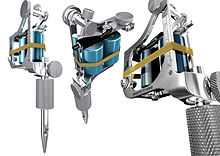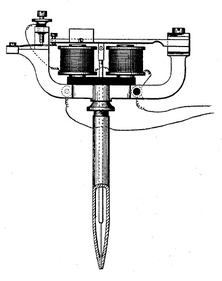Tattoo machine


A tattoo machine is a hand-held device generally used to create a tattoo, a permanent marking of the skin with indelible ink. Modern tattoo machines use electromagnetic coils to move an armature bar up and down. Connected to the armature bar is a barred needle grouping that pushes ink into the skin. Tattoo artists generally use the term "machine", or even "iron", to refer to their equipment. The word "gun" is often used but many tattoo professionals dislike it. In addition to "coiled" tattoo machine there are also Rotary Tattoo Machines, which are powered by regulated motors rather than electromagnetic coils.
History

The predecessor to the tattoo machine was the electric pen invented by Thomas Alva Edison and patented under the title Stencil-Pens in Newark, New Jersey, United States in 1876.[1] It was originally intended to be used as a duplicating device, but in 1891, Samuel O'Reilly discovered that Edison's machine could be modified and used to introduce ink into the skin, and later patented a tube and needle system to provide an ink reservoir.
While O'Reilly's machine was based on the tattoo rotary technology of Edison's device, modern tattoo machines use electromagnets. The first machine based on this technology was a single coil machine patented by Thomas Riley of London, just twenty days after O'Reilly filed the patent for his rotary machine. For his machine, Riley placed a modified doorbell assembly in a brass box. The modern two-coil configuration was patented by Alfred Charles South, also of London. Because it was so heavy, a spring was often attached to the top of the machine and the ceiling to take most of the weight off the operator's hand.
Most modern tattoo machines can control needle depth, speed, and force of application, which has allowed tattooing to become a very precise art form. Such advances in precision have also produced a style of facial tattooing that has attained mainstream popularity in America called dermapigmentation, or "permanent cosmetics" creating results such as addition/removal of freckles, beauty spots and scars.
Manfred Kohrs 1978 - Rotary tattoo machine
Classification
There are many types of machines. Liners and shaders are the more common machines from a technical standpoint. Mechanically, there are coil tattoo machines; also pneumatic machines, and rotary, or linear, tattoo machines.
- Rotary tattoo machine: A rotary tattoo machine, built in 1978 by Manfred Kohrs of Germany.[2] Rotary tattoo machines were the original machines, based on rotary technology, which was invented by Samuel O'Reilly and improved by the tattoo artists through the years. Rotary type machines use an electric motor to drive the needles. Some recent upgrades include using an armature bar to increase efficiency, a characteristic of coil machines. Recently, there have been improvements to make this type of machine pneumatic, in place of the electric motor used now.
- Coil tattoo machine: Coil tattoo machines are the most commonly seen and used. These machines use an electromagnetic circuit to move the needle grouping. There are many variations, from single-coiled machines to triple-coiled machines. They can be made from many different materials and in many different sizes and shapes. Dual-coiled machines are considered to be standard. The coils generally range from 8 to 10 wrap. The coils create the impedance, or resistance, used to properly regulate the machine's speed and power. This causes less trauma to the skin.
- Liner tattoo machine: The purpose of a liner machine is to lay the ink in the skin in one single pass to create a dominant line. It uses a short contact circuit (about 1.5mm–2mm), which causes the machine to cycle faster.
- Shader tattoo machine: The shader machine is commonly used to shade black or variants of black ink. Also colors other than black are used in this type of machine. The saturation level of this machine is low. It uses a bigger contact gap than a liner (about 2mm–3.5mm) to make it cycle slightly slower. This machine is also used for sculpting lines. Some artists will use this type of machine for all lines, as it allows the lines to be retraced with less trauma to the skin.
- Pneumatic tattoo machine: Tattoo artist Carson Hill in the year 2000 invented the first pneumatic tattoo machine and began the patent process. A pneumatic tattoo machine is powered by an air compressor, and they are extremely lightweight. Pneumatic tattoo machines use pressurized air to power the tattoo machine and drive the needles up and down. These tattoo machines are entirely autoclavable, so that the entire tattoo machine can be placed in the autoclave and sterilized fully without any major disassembly, unlike traditional coil machines which require complete disassembly before being placed into an autoclave.
Tattoo machines are not limited to just these types. A common variant is having a "cutback", which uses stiffer front springs. This is more commonly used in liners, but is known to be used on shader machines, more typically for portrait work. Machines are usually categorized into long stroke and short stroke varieties. The longer-stroked machines are good for coloring and shading, as well as sculpting lines, while doing less damage to clients' skin. Shorter-stroke machines are commonly used for lining in a single pass style, and also in a shader setup to achieve a more subtle gradation of black such as would be found in portraits. Length, width, tension, angle, and stiffness of the spring varies the functionality of the machine. The contact gaps, as well as capacitors and even the style of machine and its angles of deflection, can also all be variants in machine tuning. The proper tuning of the machine is essential for the type of machine being used, also for the type of tattoo the artist is doing.
References
| ||||||||||||||||||||||||||
| Wikimedia Commons has media related to Tattoo machines. |
| Wikimedia Commons has media related to Tattoo accessories. |